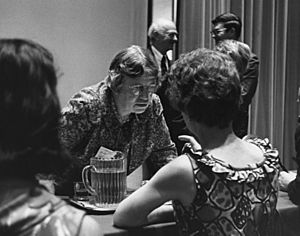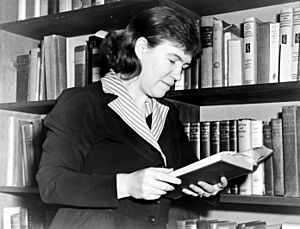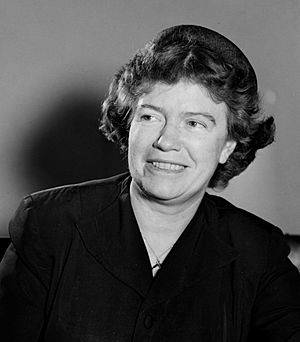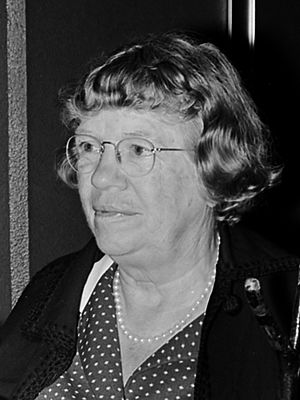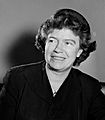Margaret Mead facts for kids
Quick facts for kids
Margaret Mead
|
|
|---|---|
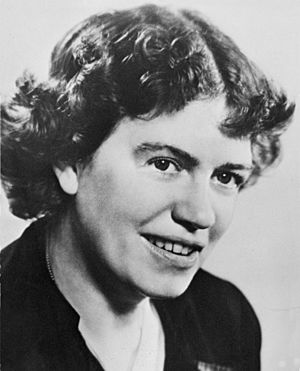
Mead in 1948
|
|
| Born | December 16, 1901 Philadelphia, Pennsylvania, U.S.
|
| Died | November 15, 1978 (aged 76) New York City, U.S.
|
| Resting place | Trinity Episcopal Church Cemetery, Buckingham, Pennsylvania |
| Education | |
| Occupation | Anthropologist |
| Spouse(s) |
Luther Cressman
(m. 1923; div. 1928)Reo Fortune
(m. 1928; div. 1935) |
| Children | Mary Catherine Bateson |
| Relatives | Jeremy Steig (nephew) |
| Awards |
|
Margaret Mead (December 16, 1901 – November 15, 1978) was a famous American cultural anthropologist. She became well-known for her writings and speeches in the 1960s and 1970s. Margaret Mead studied people and cultures around the world. She earned her college degree from Barnard College in New York City. Later, she received her master's and PhD degrees from Columbia University. In 1975, she was even the President of the American Association for the Advancement of Science.
Contents
Early Life and Family
Margaret Mead was born in Philadelphia, Pennsylvania. She was the first of five children. Her family lived in Doylestown, Pennsylvania for much of her childhood. Her father, Edward Sherwood Mead, taught finance at a university. Her mother, Emily Mead, was a sociologist who studied different groups of people.
Margaret had a younger sister named Katharine who sadly died when she was only nine months old. This was a very sad time for Margaret. She had named her sister, and she thought about her often for many years.
Her Journey in Education
Because her family moved often, Margaret was taught at home by her grandmother for a while. When she was 11, she started attending Buckingham Friends School in Pennsylvania.
Margaret Mead spent one year, 1919, at DePauw University. She then moved to Barnard College and earned her bachelor's degree in 1923. After Barnard, she continued her studies at Columbia University. There, she learned from important professors like Franz Boas and Ruth Benedict. She earned her master's degree in 1924.
In 1925, Margaret Mead traveled to Samoa to do her first fieldwork. This means she lived among people there to study their culture.
In 1926, she began working at the American Museum of Natural History in New York City. She became an assistant curator there. She received her PhD from Columbia University in 1929.
A Career in Anthropology
During World War II, Margaret Mead worked for the United States National Research Council. She was part of a committee that studied food habits. From 1946 to 1969, she was a curator of ethnology at the American Museum of Natural History. This means she helped manage and study collections related to different cultures.
Margaret Mead was recognized for her important work. She was elected to the American Academy of Arts and Sciences in 1948. She also joined the United States National Academy of Sciences in 1975. She taught at several universities, including The New School and Columbia University. She also helped start the anthropology department at Fordham University. In 1970, she became a professor at the University of Rhode Island.
Following the ideas of her mentor, Ruth Benedict, Mead focused her research on how children are raised. She also studied how personality and culture are connected. She led important groups like the Society for Applied Anthropology and the American Anthropological Association. In the 1960s, she worked on creating a universal language of graphic symbols. This project aimed to help people from any culture understand each other. Margaret Mead was a well-known figure in academics. She often wore a special cape and carried a walking stick.
Later Life and Legacy
In her later years, Margaret Mead helped many younger anthropologists and sociologists. She guided them in their studies and careers. Some of these people later became famous authors and researchers themselves. One of them, Susan C. Scrimshaw, even received the Margaret Mead Award. This award is given for sharing anthropology with the public.
In 1976, Mead was an important participant at UN Habitat I. This was the first United Nations meeting about human settlements.
Personal Life
Margaret Mead was married three times. Her first husband was Luther Cressman, who later became an anthropologist. They were married from 1923 to 1928. While returning from her fieldwork in Samoa, she met Reo Fortune. He was a New Zealander studying psychology. They married in 1928.
Her third and longest marriage was to the British anthropologist Gregory Bateson. They were married from 1936 to 1950. They had one daughter together, Mary Catherine Bateson. Mary Catherine also grew up to become an anthropologist, just like her parents.
Margaret Mead lived with fellow anthropologist Rhoda Métraux from 1955 until her death. They worked closely together on many projects.
Margaret had two sisters, Elizabeth and Priscilla, and a brother, Richard. Her sister Elizabeth was an artist. Her sister Priscilla was married to an author. Her brother Richard was a professor. Margaret was also the aunt of Jeremy Steig, a musician.
Death
Margaret Mead passed away from pancreatic cancer on November 15, 1978. She is buried in the Trinity Episcopal Church Cemetery in Buckingham, Pennsylvania.
Famous Quotes by Margaret Mead
- “Children must be taught how to think, not what to think.”
- “Laughter is man's most distinctive emotional expression.”
- “Always remember that you are absolutely unique. Just like everyone else.”
- “Never believe that a few caring people can't change the world. For indeed that's all who ever have.”
- “I learned to observe the world around me, and to note what I saw.”
Interesting Facts About Margaret Mead
- Her family owned a farm called Longland from 1912 to 1926.
- She was a member of the United States Episcopal Church.
- She is known for using the term "semiotics" to describe the study of signs and symbols.
- Margaret Mead was featured on two record albums. One was an interview about morals and anthropology. The other was a collection of talks by important women in American history.
- In 1976, she was honored by being added to the National Women's Hall of Fame.
- After her death, US President Jimmy Carter awarded her the Presidential Medal of Freedom. This is one of the highest honors a civilian can receive.
- The United States Postal Service issued a stamp with her picture in 1998.
- The Margaret Mead Award is given in her honor each year. It recognizes important works that help the public understand anthropology.
- In 1979, Margaret Mead was featured on a Supersisters trading card. These cards celebrated famous women.
- The 2014 novel Euphoria by Lily King tells a fictional story inspired by Mead's life and relationships with other anthropologists.
Places Named After Her
Several schools in the United States are named after Margaret Mead:
- A junior high school in Elk Grove Village, Illinois.
- An elementary school in Sammamish, Washington.
- Another elementary school in Sheepshead Bay, Brooklyn, New York.
Images for kids
See also
 In Spanish: Margaret Mead para niños
In Spanish: Margaret Mead para niños



